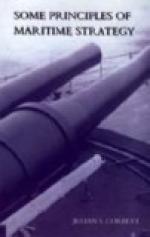If, now, we seek from the above and similar examples for principles to serve as a guide between concentration and division we shall find, firstly, this one. The degree of division we shall require is in proportion to the number of naval ports from which the enemy can act against our maritime interests and to the extent of coastline along which they are spread. It is a principle which springs from the soul of our old tradition that we must always seek, not merely to prevent the enemy striking at our heart, but also to strike him the moment he attempts to do anything. We must make of his every attempt an opportunity for a counterstroke. The distribution this aim entailed varied greatly with different enemies. In our wars with France, and particularly when Spain and Holland were in alliance with her, the number of the ports to be dealt with was very considerable and their distribution very wide. In our wars with the Dutch alone, on the other hand, the number and distribution were comparatively small, and in this case our concentration was always close.
This measure of distribution, however, will never stand alone. Concentration will not depend solely upon the number and position of the enemy’s naval ports. It will be modified by the extent to which the lines of operation starting from those ports traverse our own home waters. The reason is plain. Whatever the enemy opposed to us, and whatever the nature of the war, we must always keep a fleet at home. In any circumstances it is essential for the defence of our home trade terminals, and it is essential as a central reserve from which divisions can be thrown off to reinforce distant terminals and to seize opportunities for counterstrokes. It is “the mainspring,” as Lord Barham put it, “from which all offensive operations must proceed.” This squadron, then, being permanent and fixed as the foundation of our whole system, it is clear that if, as in the case of the French wars, the enemy’s lines of operation do not traverse our home waters, close concentration upon it will not serve our turn. If, on the other hand, as in the case of the Dutch wars, the lines do traverse home waters, a home concentration is all that is required. Our division will then be measured by the amount of our surplus strength, and by the extent to which we feel able to detach squadrons for offensive action against the enemy’s distant maritime interests without prejudicing our hold on the home terminals of his lines of operation and our power of striking directly he moves. These remarks apply, of course, to the main fleet operations. If such an enemy has distant colonial bases from which he can annoy our trade, minor concentrations must naturally be arranged in those areas.
Next we have to note that where the enemy’s squadrons are widely distributed in numerous bases, we cannot always simplify the problem by leaving some of them open so as to entice him to concentrate and reduce the number of ports to be watched. For if we do this, we leave the unwatched squadrons free for sporadic action. Unless we are sure he intends to concentrate with a view to a decisive action, our only means of simplifying the situation is to watch every port closely enough to interfere effectually with sporadic action. Then, sporadic action being denied him, the enemy must either do nothing or concentrate.




